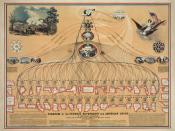Federal grants have become more common over the last 60
years, due to the expansion and retraction of the size of the
federal government. The federal government began expanding in
the 1930s to deal with the Depression. It used federal agencies
to directly deal with problems. As time went on, the tasks were
turned over to the states, but the federal government still
remained involved through the use of federal grants to states
and localities. In the 1970s, Nixon's New Federalism put a
heavy emphasis on federal grants. Revenue sharing gave federal
dollars to localities and states that had never received very
much or any federal money before. This increased local interest
in receiving federal money in many localities.
In order to deal with the federal bureaucracy and receive
federal money, localities and states have to develop efficient
and effective bureaucracies of their own. These state and local
bureaucracies must understand the federal rules and requirements
for receiving federal aid. Some states routinely receive a
greater amount of federal money than other states with similar
populations due to the differences in state bureaucracies. The
state which has an effective grant-writing bureaucracy and
maintains relations with federal bureaucrats and leaders is
often able to get more money.
Federal bureaucracies are often very regionalized. They
are staffed by people from a certain region, and they primarily
deal with people from that region. They give more federal
assistance to these regions too. The overall trend in federal
spending in a state may be different from a particular agency's
pattern of spending. Some states may get very little overall
federal funding, but may get much more than the average amount
of money from a certain federal agency's grants.
American state-level politics can be divided up into 3
categories: traditional, moralistic, and individualistic.


